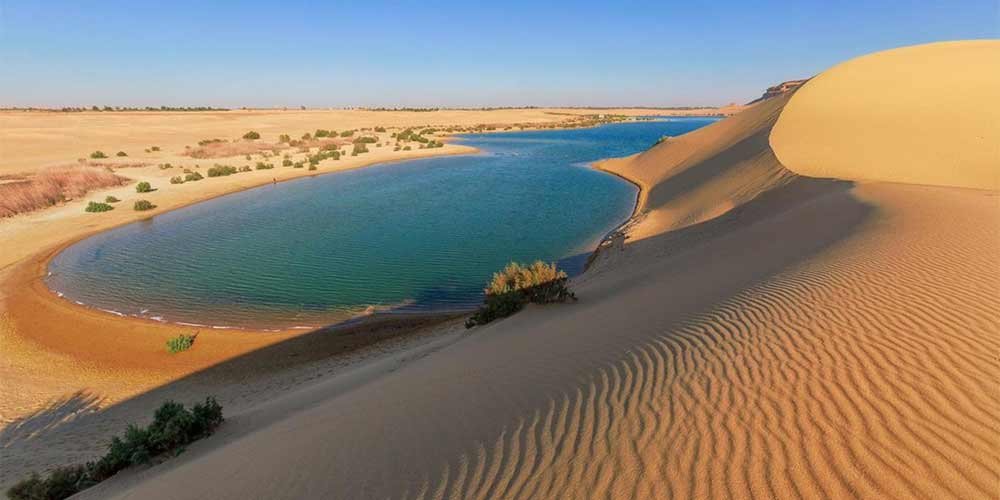Wonderful facts about the 10 most famous places in Fayoum.
Egypt has 6 oases but EL Fayoum is the largest one. It is located at 70 Km southwest of Cairo. EL Fayoum oasis mixes between natural beauty, ancient history, and heritage sites such as Lahun Pyramid, Hawara Pyramid, Wadi El-Rayan Protectorate, Wadi El- Hitan, Lake Qarun, Qasr Qarun, Kranis city, Tunis Village, and waterwheels.
What is the origin of EL Fayoum word?
EL Fayoum word is derived from the ancient Egyptian word (Baym) meaning sea or lake that refers to the existence of a great lake in this place.
What is the history of EL Fayoum oasis?
The history of EL Fayoum began during ancient times, but the golden age of this oasis started when it became the capital of ancient Egypt (named Itjtawy) during the 12th dynasty, Middle kingdom. Additionally, it was the center for worshipping the god Sobek.
During this period EL Fayoum was distinguished by economic and structural prosperity whereas it houses the kings’ pyramids and funerary temples dating back to the 12th dynasty. Most of these pyramids are in poor condition.
EL Fayoum had a great position also during the Greco-Roman, Christian and Islamic periods.
1 – Lahun Pyramid
Lahun pyramid was built by king Senusret II during the 12th dynasty, Middle Kingdom. It was made of mud bricks and coated with limestone for ensuring the stability of the pyramid construction.
2 – Hawara Pyramid
Hawara pyramid was built by Amenemhet III during the 12th dynasty, Middle Kingdom. It is known also with the Black Pyramid because it is made of mud bricks. Unfortunately; the pyramid is at risk of collapse because of the many architectural mistakes in its construction. Besides, as usual, in most of the pyramids of the middle kingdom, this pyramid distinguishes with the existence of mazes that help hide the burial chamber from grave robbers.
3 – Valley of the Whales or Wadi El- Hitan
Wadi El- Hitan is a fossil area that is a part of Wadi El-Rayan Protectorate was discovered in 1936. It dates back 40 million years. UNESCO considers it as a World Natural Heritage Site.
What can be seen in Wadi El- Hitan?
- Wadi El- Hitan contains invaluable petrified primitive whale fossils such as skeletons, teeth, shells for whales and other sea creatures.
- The valley distinguished with movable dunes, four natural sulfuric springs, and protecting dome endangered animals.
- This valley holds Wadi Hitan Fossil and Climate Change Museum that discusses the damaging effect of climate change on the rich of the environment is addressed to raise awareness. Besides, the museum displays different fossils, and the masterpiece in this museum is the largest whale skeleton discovered. This skeleton is measuring 21 meters long. The museum also exhibits sea cows, turtles, sharks, rays, crocodiles, and early forms of elephants.
Why are these whales here?
In the past, this place was a coastal environment that explains the existence of these fossils here. This place shows the evolution of whales from land animals to their changing into sea creatures.


4 – Wadi El-Rayan Protectorate
Wadi El-Rayan protectorate was founded in 1989 to protect the endangered flora and fauna such as the Fennec Vulpes zerda and the Dorcas Gazelle. When you visit Wadi El-Rayan, you can enjoy with its desert environment with natural springs, dunes, and various varieties of plants, mammals, reptiles, and species of resident and migratory birds, as well as, you can practice some sports such as sea sports in the waterfalls area and sand-boarding.

5 – Lake Qarun Protectorate
Lake Qarun is created when the Nile River flooded EL Fayoum since 70,000 years ago. It is one of the oldest natural lakes in the world. Lake Qarun is famous for preserving several kinds of fossils dating back about 40 million years that attracts tourists from different destinations. Lake Qarun was considered as a protectorate since 1989, as well as, UNESCO listed it among world heritage sites.
What can be seen in Lake Qarun?
This protectorate is the home for reptiles, amphibians, mammals, and water birds, especially the flamingo. Additionally, you can see the fossil of the oldest monkey in the world dating back to the Oligocene era was found and petrified trees.
You can enjoy and relax by taking a ride on a boat through Lake Qarun.
6 – Qasr Qarun or Qarun Palace
The great Abu Simbel temple is not the only temple where the sun illuminates its Holy of the Holies, but Qasr Qarun also has this amazing phenomenon occurring on December 21st every year. It is a Ptolemaic temple dedicated to Sobek then Dionysus (the Greek god).

7 – Karanis City
Karanis is a city that has several buildings dating back to different periods such as:
- The building dating back to the ancient Egyptian period is a temple date back to the 12th dynasty. It was dedicated to the crocodile God Sobek and the Goddess Isis.
- The buildings dating back to the Greco-Roman are temples, cisterns, public baths, and cemeteries.
- Kom Ushim Museum is opened in 1974 for displaying the history of EL Fayoum, as well as the lifestyle of EL Fayoum community throughout history. This museum also distinguishes by holding Fayoum Portraits dating back to the Greco-Roman period.
8 – Tunis Village
What is the history of Tunis village?
This village is established in the 60s. After Evelyne Porret (A Swiss woman) visited it in the 80s, she decided to establish a pottery school to revive the pottery industry in EL Fayoum and teach residents there.
It is worth to visit to see if you are skilled in making pottery, buy pottery works, and enjoy staying in a lodge for having a traditional Egyptian breakfast.

9 – Waterwheels in EL Fayoum
EL Fayoum oasis is famous also for waterwheels. There are 4 waterwheels. They were invented by the Ptolemies. Waterwheels are a tool used in agriculture for irrigation.

10 – Gabal El-Medawara
It is a unique place for hiking, camping, and enjoying with sky stars overlooking the Magic Lake. It is worth to visit.
If you want to spend a unique adventure, Explore Egypt Tours offers to EL Fayoum day tour to enjoy cultural and historical sites, lakes and deserts.


Comment (0)